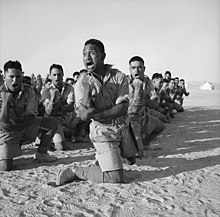Foreign relations and military
Māori Battalion haka in Egypt, 1941
In 1951 the United Kingdom became increasingly focused on its European interests,[88] while New Zealand joined Australia and the United States in the ANZUS security treaty.[89] The influence of the United States on New Zealand weakened following protests over the Vietnam War,[90] the refusal of the United States to admonish France after the sinking of the Rainbow Warrior,[91] disagreements over environmental and agricultural trade issues and New Zealand's nuclear-free policy.[92][93] Despite the United States' suspension of ANZUS obligations the treaty remained in effect between New Zealand and Australia, whose foreign policy has followed a similar historical trend.[94] Close political contact is maintained between the two countries, with free trade agreements and travel arrangements that allow citizens to visit, live and work in both countries without restrictions.[95] In 2013 there were about 650,000 New Zealand citizens living in Australia, which is equivalent to 15% of the population of New Zealand.[96]
Anzac Day service at the National War Memorial
New Zealand's armed forces—the Defence Force—comprise the New Zealand Army, the Royal New Zealand Air Force and the Royal New Zealand Navy.[103] New Zealand's national defence needs are modest, since a direct attack is unlikely.[104] However, its military has had a global presence. The country fought in both world wars, with notable campaigns in Gallipoli, Crete,[105] El Alamein[106] and Cassino.[107] The Gallipoli campaign played an important part in fostering New Zealand's national identity[108][109] and strengthened the ANZAC tradition it shares with Australia.[110]
In addition to Vietnam and the two world wars, New Zealand fought in the Second Boer War,[111] the Korean War,[112] the Malayan Emergency,[113] the Gulf War and the Afghanistan War. It has contributed forces to several regional and global peacekeeping missions, such as those in Cyprus, Somalia, Bosnia and Herzegovina, the Sinai, Angola, Cambodia, the Iran–Iraq border, Bougainville, East Timor, and the Solomon Islands



No comments:
Post a Comment